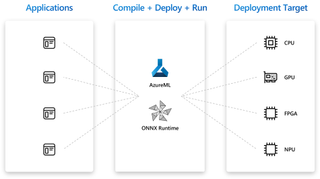Microsoft and Qualcomm’s Project Volterra is All About Neural Processing
Project Volterra is part of Microsoft's "Hybrid Loop" of computing.

For those looking for major news about Windows 11 at Microsoft Build, bad news, you're out of luck. But if you want to see new AI-based hardware for developers designed to serve as a new compute workload that mixes a local system and the cloud, there's a lot to unpack.
At the annual developer conference, which is being held virtually for the third year in a row, Microsoft is preparing a world beyond just the CPU, but also NPUs (neural processing units) and, of course, cloud computing. The company is discussing what it calls the "Hybrid Loop" — cross-platform application development for building artificial intelligence applications. (AI, as it has been the last few years, is a huge theme at Build this year.)
"In the future, moving compute workloads between client and cloud will be as dynamic and seamless as moving between Wi-Fi and cellular on your phone today," Panos Panay, the head of Microsoft's Windows and Devices division, wrote in a blog post.
To aid in that development, Microsoft announced hardware aimed at developing AI. Project Volterra, as it's currently dubbed, will use the Snapdragon compute platform (no specific Qualcomm chip was mentioned) and the newly announced Qualcomm Neural Processing SDK for Windows toolkit. This should allow developers to "explore many AI scenarios," Panay added.
Expect more support for NPUs to be built into Windows. Panay suggested that NPUs will be in the majority, if not every computing device at some point in the future.
To work with the Arm-native hardware, Microsoft is making a series of tools Arm native, including Visual STudio 2022 and VSCode, Visual C++, Modern .NET 6 and Java, the classic .NET Framework, Windows Terminal, the Windows Subsystem for Linux and the Windows Subsystem for Android.
No price was announced for Project Volterra, but Panay wrote that it's coming "later this year."
The Hybrid Loop
In theory, this all makes Project Volterra (and similar future hardware) primed for what Microsoft sees as the future of computing: workloads that shift dynamically between your local computer and cloud inferences in Azure. This could work for heavy developer jobs, such as training an AI.

Microsoft refers to the Hybrid Loop as a "development pattern" for building AI applications. This pattern will work through Onnx Runtime and a Prototype AI toolchain Azure ML. Microsoft was short on details otherwise, but hopefully, we'll learn more about what development (and other) workloads Microsoft expects to see available on Windows.
Stay on the Cutting Edge
Join the experts who read Tom's Hardware for the inside track on enthusiast PC tech news — and have for over 25 years. We'll send breaking news and in-depth reviews of CPUs, GPUs, AI, maker hardware and more straight to your inbox.
Andrew E. Freedman is a senior editor at Tom's Hardware focusing on laptops, desktops and gaming. He also keeps up with the latest news. A lover of all things gaming and tech, his previous work has shown up in Tom's Guide, Laptop Mag, Kotaku, PCMag and Complex, among others. Follow him on Threads @FreedmanAE and Mastodon @FreedmanAE.mastodon.social.
Most Popular



